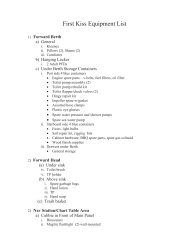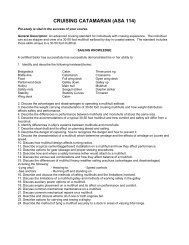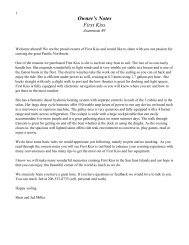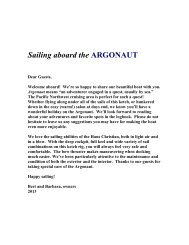Hunter 356 âISLAND ESCAPEâ Owner's Notes - San Juan Sailing
Hunter 356 âISLAND ESCAPEâ Owner's Notes - San Juan Sailing
Hunter 356 âISLAND ESCAPEâ Owner's Notes - San Juan Sailing
You also want an ePaper? Increase the reach of your titles
YUMPU automatically turns print PDFs into web optimized ePapers that Google loves.
BOARDING LADDER<br />
A small white boarding step is provided at the <strong>San</strong> <strong>Juan</strong> <strong>Sailing</strong> dock for Island Escape. This step folds<br />
and may be taken aboard for use at other ports of call. There is also a larger blue set of steps located in<br />
the port lazarette which are more secure and make it easier to get on board when at dock.<br />
BOAT SPECIFICATIONS<br />
All boat specifications such as LOA, LWL, draft, tank capacities, serial numbers, etc., can be found in the<br />
front of the guest book.<br />
CD PLAYER/STEREO<br />
The Sony CD player operates like a car stereo<br />
Simply experiment with the regular buttons to gain familiarity (see instruction guide in the front of this<br />
notebook for added detail). To load a CD, the “open” button is located in the right upper corner. The Front<br />
panel will swing down for you to put the CD into the black felt slot (red light underneath it). To play the<br />
CD, close the panel and it should play automatically. To change tracks, press the ‘seek’ button on the<br />
right of the panel. To take the CD out, reopen the panel and press the red eject button to the left. Close the<br />
panel. The stereo will beep three times when the unit is turned off on the main control panel. This is<br />
normal.<br />
Use the “FADE” function to activate the speakers in the cockpit, to have both inside and outside speakers<br />
operating, or to return audio to the cabin only. This unit also has a jack for aux. players such as ipod/mp3<br />
players.<br />
DINGHY<br />
ISLAND ESCAPE has a hard bottom inflatable 10’2” Avon RIB dinghy. For tie-up after anchoring or for<br />
towing, you should tie on the starboard side to avoid the furnace outlet vent. Towing works best when the<br />
dinghy is brought close to the boat—about 4 or 5 feet off the stern. This lifts the bow, reduces drag, and<br />
lessens the chance of wrapping the painter around the propeller. Tie the painter off twice—once at a<br />
portside cleat then tie the bitter end to the stern rail. Keep track of the oars as well. The oars should be<br />
stored flat inside the dinghy when under tow.<br />
Island Escape has a Honda 2-HP 4-stroke outboard motor. See the section in these notes for “Outboard<br />
Motor” for additional information and operating instructions. The outboard motor holds about 1/3 rd gallon<br />
of regular gas (no oil mixing is needed!) Do not store spare gasoline on the boat except inside the<br />
outboard engine. An extra gas container is secured inside the dinghy. The inflating pump is stored in the<br />
small bow locker of the dinghy, together with a pump-out hose and limited repair kit. (See section<br />
“Outboard for motor operating instructions.)<br />
PLEASE check regularly that the dinghy drain plugs on the transom are SECURLY in place prior to<br />
towing or heading out to the crab-pot or for ice cream ashore!<br />
Please use special care when beaching the dinghy (refer to the dinghy beaching procedure in your charter<br />
guest book). Most of the beaches in the Islands are strewn with barnacle covered, bottom slicing rocks.<br />
When approaching the shore, weight the dinghy aft by leaning or moving toward the back of the dinghy.<br />
Revised/Updated 03/2013<br />
Then offload everyone over the bow. Lift the dinghy/outboard motor using the hand lines on either side<br />
above the barnacle “line”, and deposit the dinghy gently on the beach. Also remember to secure the<br />
‐ 8 ‐








